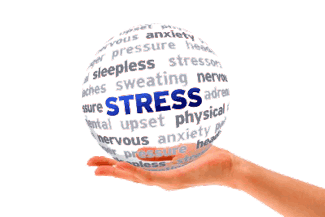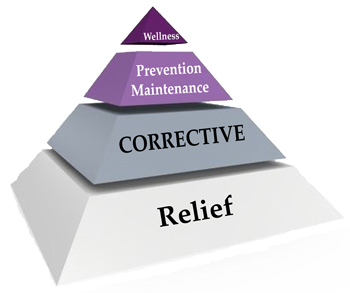Phases of Care
and What to Expect from Treatment

Rebuilding Your Foundation and Holistic Phases of Care
Due to the holistic nature of the body, healing is always achieved in phases. In Holistic Medicine this principle is known as holistic systems integration. In the phases of care that we follow at Cherubino Health Center, we sometimes compare it to the building or repairing of a house.
Certain structures and systems need to be in place in order for other “functions” of the house to work properly. From this perspective a well functioning building depends on multiple systems working in harmony with one another in a “holistic manner”.
The Holistic Nature of a House
For example, you wouldn’t expect your sink or your toilet to work properly unless it was connected to a functional plumbing system. This is an example of holistic principles in action.
For example, windows cannot be installed before building walls.
Similarly, it is not possible to fully heal a damaged tendon, joint, muscle or organ until it has adequate movement, nerve supply, and blood supply.
Your body has a certain natural order of operations that needs to be followed in order for it to repair itself correctly and fully and for maximum healing to occur.
We follow four general holistic phases of care, the particulars of which are dependent on your individual needs and goals.
Phases of Care
1 – 4
Phase One: Relief Care
In this first phase of treatment, relief of your symptoms is the top priority.
For those suffering from pain, discomfort, and associated symptoms, the relief phase of treatment is especially important. We have found that relief care in combination with corrective care, is an effective way of reducing symptoms while still correcting its underlying causes.
For many people their first introduction to chiropractic, alternative or holistic healthcare comes when they are seeking relief of their symptoms from a holistic treatment approach that does not involve the use of drugs or surgery.
However, whether holistic healthcare is your first choice or you are seeking it because other methods have failed, relief of your symptoms is almost certainly a top priority.
Depending on the severity of your symptoms, frequency of visits for chiropractic or other holistic approaches may be 2 – 3 visits per week. And depending on individual needs, certain holistic treatment protocols may require daily visits for a short period of time.
Understanding How the Phases of Care Relate to Symptoms
As symptoms improve, it is common for people to confuse the relief that they experience from this phase of treatment with complete recovery.
Here are some facts from a holistic, whole body perspective:
- Pain and other symptoms are oftentimes late indicators of disease and illness. In these cases symptoms only appear after their underlying diseases and conditions have become advanced. These are known as “silent conditions”.
- Typically, pain arrives late and leaves early. Effective holistic healthcare often times relieves symptoms quickly, in spite of the fact that much of the underlying condition remains unhealed. Many people conclude that they are “fully healed” when they are merely symptom-free.
- Fortunately, these silent conditions do respond to corrective care based on what are known as holistic indicators. Overview of Holistic Functional Medicine
Phase Two (Phases of Care): Corrective Care
This is the phase of care where maximum healing is achieved!
Corrective care is the heart and the soul of any whole body approach to health and healing. Identifying and treating the underlying causes of symptoms, conditions and diseases is in essence what natural holistic healthcare is all about. At Cherubino Health Center we’ve been positioned on the leading edge of this movement since we treated our first patient in 1982.
Since that time we have helped thousands of people regain and maintain their health by the use of what is known as functional holistic medicine. This type of medicine seeks to identify the root cause of a condition and the specific dysfunction associated with it. Corrective care seeks to fully correct these underlying conditions.
The goal with corrective care is to become both symptom-free and indicator free. This is possible only when root causes are understood and corrected. Ultimately, it is also important to understand the difference between an indicator and a symptom.
Indicators versus Symptoms
By definition, symptoms are the result of underlying conditions that involve dysfunction someplace in the body. This can involve the malfunction of nearly any part of the body including cells, organs, joints, muscles, arteries, bones and nerves, to name but a few. In practical terms, symptoms can be experienced through a person’s basic senses, whereas indicators cannot.
In nearly every instance, indicators can only be identified by a doctor or other practitioner that has been specifically trained to do so. Therefore, symptoms are subjective and indicators are far more objective and require an appropriately trained professional to be identified and understood.
The fact is that symptoms alone are quite unreliable. A case in point is that symptoms may be severe as the result of a relatively minor cause, for example a hangnail. On the other hand, symptoms are very often nonexistent in spite of the presence of extremely serious and life-threatening conditions such as heart disease or various forms of cancer. Statistically, every few minutes in this country a person suffers a fatal heart attack. Many of those people will have had no symptoms prior to the incident.
The majority of chronic conditions have numerous indicators associated with them long before any symptoms are present. That is why using indicators such as EMI results, reflex and energy pulses, saliva, urine and blood testing, nerve point evaluation and tracing, muscle trigger points and spinal joint restrictions are far more reliable and valuable than looking at symptoms alone.
Phases of Care – Three and Four: Wellness, Maintenance and Preventive Care
“Maintaining order rather than correcting disorder is the ultimate principle of wisdom. To cure disease after it has appeared is like digging a well when one feels thirsty or forging weapons after the war has already begun.” – Nei Jing

Wellness care is all about early detection, maintenance and prevention. It may also be the single most important holistic service that we render at Cherubino Health Center. It is also, unfortunately, the most poorly understood.
Because of our conditioning at the hands of Western medicine (and please be assured that nearly every one of us who has been brought up in this country is thoroughly conditioned) we feel that there is either no such thing as preventive healthcare or that it is totally unnecessary. Small wonder, when we are taught that the temporary elimination of a symptom with a drug is considered the cure for a disease. Both statements are incorrect.
Because of the inherent ability of hoistic, nervous system based health care to identify, utilize and understand what are known as indicators, it is possible to identify problems, correct them with treatment and prevent their recurrence without any of the usual “symptoms” that we have been taught must exist if we are in real need of, or could benefit by, medical attention.
Portrait of a couple with their son and daughter
Wellness and preventive holistic healthcare of the type that we use at Cherubino Health Center, has been used worldwide for many decades with tremendous success. And has eliminated the causes of future diseases, distresses and disturbances of the human body.
Many people actually do more to maintain the “health” of their automobile than they do to maintain the health and function of their own body. Once the body has reached a state of maximum improvement, with the phases of care one and two, routine evaluation (early detection) and holistic corrective treatment is necessary to maintain your body in optimal condition.
Similar to continuing with a healthy eating program and routine exercise, some level of holistic nervous system based treatment is imperative if one is to maintain a high level of health and function. We’ve actually had patients that have equated their ongoing holistic wellness care with regular oil changes for their car. One patient in particular likes to say, “I am worth the time, money and effort.”
While many people falsely believe that if they are “symptom-free, they are as healthy as can be”, the ideal time to be checked and treated is before symptoms occur. It may seem like a radical idea but it is actually a simple statement of fact and is supported by the principles of holistic medicine.
When you make regular evaluations and holistic treatments a part of your lifestyle, you deter the establishment of disease and ensure maximum function and health of your nervous system, tissues and organs. It’s the best way of maintaining a high level of health in spite of the ever present stress under which we all live.
Ask your practitioner about the phases of care and what they recommend based on your individual and holistic circumstances.

